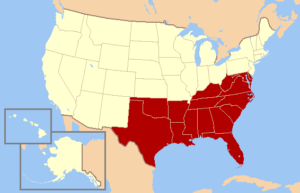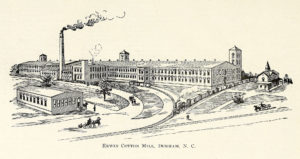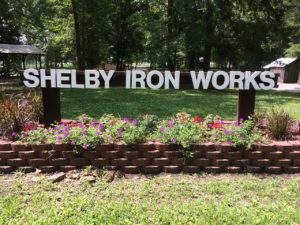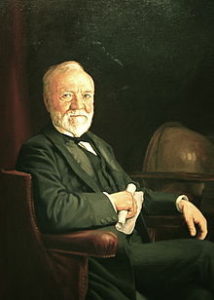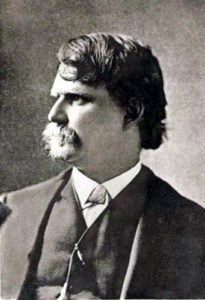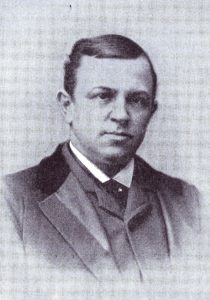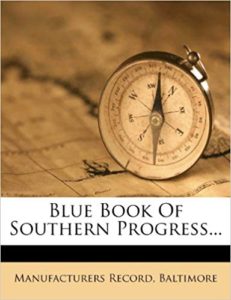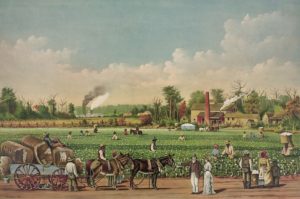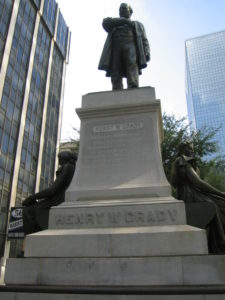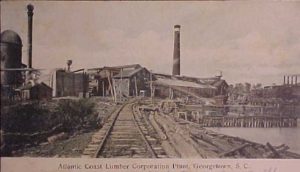Introducing the “First” New South
The current post-Civil War buzz that captures the most attention, and is certainly most relevant to our ED history, is the so-called “New South Movement“. In that “hope springs eternal”, the reader might anticipate this is the first of several “new Souths” to be discussed in our history.
The “first” New South Movement is considerably important to our ED history. From it we can trace the rise of modern, southern industrial-urban ED to this grouping. Of course, southern industrialization and the rise of its business/commercial class started during the antebellum period, but set adrift in a Sargasso Sea of slave-cotton-export agriculture, it never acquired sufficient momentum to sufficient to diversify the South’s economic base to any meaningful extent. That changed during, and after the Civil War and from 1880 into the future, southern industrialization assumed an ever-increasing economic importance. The rise of the post-Civil War New South Movement, therefore, should be considered as the front page of modern southern economic development.
The key to how we approach this “First New South”–and the others to follow–is how we deal with “the Old South”. The temptation, not always resisted as one or another New South is discovered, is to forget the Old South will remain, either embedded into the proponents of a New South, or alongside it in different geographies and in other actors that remain in the usually contentious southern policy system.
The “First” New South Movement consisted of a cluster of initiatives and a wide variety of different advocates and groupings. It enjoyed uneven success, geographically and culturally. Geographically it was bi-modal: Coastal-Borderland states and Texas. The hard core New South Movement, which captures the greatest attention, today was arguably the most cohesive element in the initial Redeemer policy system during the 1870’s. Composed of southern Whigs, and the first generational cohort just starting out–and led at that point by powerful urban newspaper editors, jelled in the 1880’s.
After that, northern investors and business firms entered the picture chiefly in railroads and heavy industry. They remained powerful for quite some time. Overlapping northern railroad and heavy industry investment, was the rise of a native generational cohort that were drawn into several entrepreneurial ventures in attractive sectors: tobacco and textile mills in particular–the latter were among the South’s most productive city-builders. During the 1890’s the urban merchant business community, fueled by successive generational cohorts and successful past entrepreneurism, established itself in chambers and other business organizations and became a force to be reckoned with in the urban policy process. Its golden years were the 1920’s–which shall be discussed in a future theme.
Lest the reader develop a tunnel vision in which the New South comprises the total picture imagined by the reader, the New South always co-existed with an allied southern planter class, and confronted a mostly rural economy and population–desperately poor–and, a populist-inclined electoral majority that were decidedly not friendly to the New South Movement. As described in the last module, the Redeemers were not without their own internal troubles. No one should assume that the New South Movement is the South’s most powerful grouping or political force–certainly not in this period, if ever. There is always a lot more going on in southern policy systems than the antics of the New South.
Internal Composition of the First New South Movement
Four main groupings constituted its 19th Century membership. The first appeared during Reconstruction in the form of sincere, and corrupt, northern entrepreneur carpetbaggers, southern Whigs, and northern businesses seeking opportunities. Beginning during Reconstruction and continuing through the 19th Century, but little-appreciated, northern industrialist families acquired/developed a special taste for investing in southern industrialization. Each of these played a major role in addressing the most obvious, and most crippling southern industrialization-related weakness: lack of investment capital.
Large [northern manufacturing interests have sprung up in Birmingham and all this District… controlled by General Tyler of Pennsylvania; Tecumpsa Furnace controlled by Ohio people; the Shelby Iron Furnace, the largest in the state … controlled by Hartford Connecticut people–the Stonewall Furnace, the Aetna Furnace, Cedar Creek Furnace–all controlled by northern men who will cooperate if the proper influences are brought to bear [1]
The second grouping, southern Whig Redeemers, in power in certain states and southern geographies during the 1870’s (coastal and highland states, counties and cities). Whig Redeemers were native antebellum, southern-born Whigs that became Democrats in the post-Reconstruction one-party South. They are distant cousins to mainstream northern Republicans of the day (called cotton Whigs in the antebellum South, and Bourbon Democrats in the post-Civil War). They advocated industrialization and railroad development as the primary southern ED approach.
The third element, which in my view provided the first New South Movement its sustenance, muscle, and over time emerged as the true New South leadership, came from from what Doyle describes as “an aggressive throng of merchants, industrialists, and entrepreneurs of every stripe, men who were from the most part, indigenous to the South but eager to remake the region in the image of northern industrial society“. He likens these folk to a middle-class movement that persisted across several generations–what I call generational cohorts [2]. William Nicholls describes these new southerners as the “beginnings of a more effective and vigorous middle class” who developed as “little islands of industrialism” in the towns and cities throughout the South after the Civil War:
trade and manufacturing came almost entirely into the hands of new businessmen whose origins were largely from the South’s non-slave-holding rural yeomancy, and whose spirit once freed of the restraints of the southern agrarian society increasingly resembled that of their counterparts in other regions [3]
Woodward also compares these entrepreneurs to those that transformed the North more than fifty years earlier. They are the ones to watch in our ED history. To them we can trace the rise of southern industrialization, and urbanization–in this period they can serve as the functional equivalent to western-style city-builders of this period–along with railroads, of course.
Since they are so important to our history, a more detailed look at these southern generational cohorts is warranted. With each future generation a surprising number of young southerners pursued capitalist opportunities in southern cities, often from hardscrabble scratch, but with youthful vigor, innocence–and a backbone of often unrecognized greed and self-interest. Preaching to those who would listen they represented a “Gospel of Prosperity”, these men were not saints, nor were they simply greedy insincere white supremacists. The were (mostly) men raised in the South with a ill-defined public mission seeking economic and personal opportunity –and they were not organized. Mark Twain described them as “brisk men, energetic of movement and speech; the dollar their god, and how to get it their religion” [4] Their first page-turning appearance will be described in a future module on the rise of southern textile and tobacco industries.
These entrepreneurs spent several decades trying to get their act together, and they eventually did so in the 1890’s using chambers of commerce, and more political, action-oriented, associations. They enjoyed what success they could muster at the urban level mostly; their success was both uneven and two-step forward, one back nature. They worked in alliance and in opposition to the southern planter/agriculture aristocracy. They exhibit their version of the South’s Divided Mind syndrome.
The fourth group is likely the one you read about in your American history classes, described in textbooks using the words/lives of the South’s major newspaper editors/publishers. One of the earliest was Louisville’s Courier-Journal editor (“Marse”) Henry Watterson, born in DC, he was a former Confederate soldier under Nathan Bedford Forrest [5]. He advocated for tax incentives, business subsidies, and privileged franchises (railroads, for example as we shall discover in our next module). Particularly concerned with attracting northern investment into Kentucky, Watterson upon election to Congress embraced a late-19th Century form of globalism, lovingly called imperialism. He also advocated something called free trade which in the South was a major heresy.
Charleston’s New South advocate, another ex-Confederate, the News and Courier editor, Francis W. Dawson. Dawson urged that Charleston should begin “the importation of about five hundred Yankees with the right stripe [to] put a new face on affairs, and make the whole place throb with life and vivid force“. He strongly pushed for a diversified Carolina economic base, and paved the way for SC to embrace the rising textile mill sector–and tobacco processing sector as well. He allied with populist Pitchfork Ben Tillman, then repudiated him. Dawson functioned in a difficult South Carolina atmosphere, as Charleston was in decline during these years. His hope, however, was to make Charleston the Pittsburgh of the South (which he thought of as a mixture of Boston and Chicago ?).
Henry O’Grady, the Atlanta Constitution’s owner/editor/publisher is today’s poster boy for the New South Movement. Charismatic, charming, aggressive, a fantastic public speaker and orator, he traveled across the South and North advocating southern industrialization. In one NYC speech, with General Sherman in his audience, he stressed northern investment was absolutely necessary to the South’s future, while gently chiding the General for being a “mite careless about fire“.
It was O’Grady who made famous, the ever-quoted funeral metaphor: “the South didn’t furnish a thing on earth for a [southern] funeral but the corpse and a hole in the ground“. He did what he could to stimulate northern investment, but throughout the South he stressed the pitfalls of becoming a mere northern colony. Recognizing his audience, O’Grady in his various northern speeches cultivated an image of southern race relations that made northern investment less disturbing. He published Joel Chandler Harris’s Uncle Remus and stressed the New South’s racial humanity: “I want no better friend than the black boy who was raised by my side … I want no sweeter music than the crooning of my old mammy“[6]. Listeners such as J.P. Morgan and his lawyer, H. M. Flager were much impressed, and future modules will detail their subsequent involvement with southern industrialization.
Less noticed in the period previous to 1890 was that Baltimore effectively served as the unproclaimed capital of the New South Movement (highly contested by Atlanta, and Richmond). Johns Hopkins was regarded as a “southern” university; southern-born Woodrow Wilson studied and taught there–arriving in New Jersey only in 1890.
In 1879, twenty-three year old William Yonge set up Chattanooga’s business’s first newspaper, the Tradesman, but in 1882, twenty-five year old Richard Edmonds founded what became the business newspaper of the South, the Manufacturers Record in Baltimore. “Spread on the pages of the Manufacturer’s Record were weekly reports on the triumphs of southern capitalism, investments new establishments, letters and speeches from northern capitalists The Journal described itself as a ‘thoroughly southern newspaper, thoroughly identified with the new South'” [7]. Edmonds set an example and offered inspiration to the diffusion of business publications throughout the South, including the Texas Trade Review which credited Edmonds as its inspiration.
Tennessee, a hotbed for the New South manufacturing and industrialization, witnessed a slew of governors, mayors, and businessmen that were New South leaders. Nashville was the better-known example of 19th Century southern highland industrialization, but its eastern neighbor, Knoxville has been used in a following module as our case study. Here, I call attention to J. B. Killebrew a Tennessee state education official who in 1872 noted Southern agriculture had a productivity problem whereby “one person in the rigorous climate and poor soil of Massachusetts [produces] nearly three times as much as one in the rich fields and genial climate [?] of Tennessee“. Anticipating the current knowledge-based ED paradigm, his solution was an educated working class [8].
Nineteenth Century New South Beliefs and Initiatives
New Southerners were unapologetic capitalists, and argued strenuously for limited government. This they shared with Planters–as well as belief in the power of cheap labor to attract northern and business investment. Their shared “third rail” was low taxes–which should never be increased. Cheap labor was exceeded only by cheap government–these years were among the least generous toward services, especially education at virtually any level. A non-existent K-12 educational system translated into child labor in plantation fields and textile mills [9]. Make no mistake there are New South fingerprints all over the 19th Century southern business climate.
The New South-Planter state coalition was an inside-out, upside-down unknowledge-based ED–the less education, the more economic development. Hidden-in-plain-sight is the de facto formulation of the South’s infamous business climate. That climate was based on a shared political consensus that could never have raised taxes, advocated for education, or an activist government, and it hated public-private partnerships, preferring instead as pure a capitalism as could be devised, with a government that when appropriate tossed necessary incentives at railroad infrastructure, owned and operated by railroad corporations.
That new business elite created by the New South Movement plays an important role in southern urbanization and industrialization, and would prove to be the prime force instrumental in forging “modern” southern S&L policy systems, and fabricating “modern” southern-focused ED strategies and programs. That business elite “took off” as subsequent post-Civil War generational cohorts entered into, and participated in, the S&L policy systems that followed. These elites, however, necessarily had to contend with the other groups, cultures, and classes who simply would not go away. That reality is what prompted Woodward to stress the South’s Divided Mind.
The Planter Class, as Woodward correctly observes, gathered more power as the 19th Century drew to its close. New South did not dispute the primacy of southern agriculture in the southern economic base. Rather New Southerners argued industrialization was a legitimate, totally necessary, and vitally crucial secondary path which Planters, however uncomfortable, did not seriously dispute. The Divided Mind was a two-way street, with both planters and New South industrialists keeping one foot in each of the two economic bases (talk about mixed metaphors-I love it). This alliance persisted in part because Planters and New Southerners also shared a basic sympathy, if not loyalty to much of “the Old South”. The New South was not construed as a rejection of antebellum South, nor of the Civil War heritage that was integrated into a southern culture during his period.
Adherence to the “Lost Cause” alongside a glittering vision of a ‘metropolitan’ and ‘industrial’ South to come, New Southerners embraced a nostalgic vision of the past. One of the most significant inventions of the New South was the ‘Old South‘–a new idea in the [1880’s]” [10], More importantly, the New South Movement supported Planter Class views on African-Americans and their place in southern society and economics. In the 1890’s Atlanta New Southerners would make their peace with Booker T. Washington, but until then they would not come close to meeting current litmus tests on race. Atlanta’s Henry O’Grady, the personification of the New South Movement, said, very clearly, as late as 1888 “the supremacy of the white race of the South must be maintained forever, and the domination of the Negro race resisted at all points, and at all hazards, because the white race is the superior race” [11]. He died two days before Christmas a year later–he was 39.
Federal/State Land Sales as an ED Strategy
Early on in this module I made an observation that the South’s critical deficiency was capital to invest. One might wonder how the New South Movement was able to gather momentum in these early years? One important factor was involvement of the federal government–in the form of land sales to entrepreneurs, investors and railroad corporations. These land sales were massive in scale, and was the closest the South would come to western-style homesteading and transcontinental railroads. The feds motivated state governments to similarly sell their land as well. Land does not always wind up as farms; in the South’s case, much went for mines, lumber/saw mills, textile mills, factories, and, of course, much needed railroad development.
Post-1870’s federal (and state-level) land sales initiatives opened the door for external financiers to enter the South, New Southerners often piggy-backed with them. Government land sales are a little-appreciated ED strategy/program. In current form federal public land has been largely withdrawn from sale to private buyers (Arctic and coastal wind-power, for example), and federal management of its owned land has been a major issue in the so-called Sage Bush Rebellion, and in management of national forests/wildfires. Local government had turned land sales in reverse, through land-banking, to an important CD strategy. Even urban redevelopment has turned land sales into a more convoluted sale-leaseback public/private strategy. Land has proven itself a powerful, yet clumsy asset in ED practice.
In the 19th Century land sales were a primary federal and state economic development strategy. I invite the reader to compare the role of railroads, railroad city-building land sales and Midwest homesteading in our Minnesota case study with this South module. In the next Theme (4) on the West we will again see land sales, railroads, city-building and wide-spread corporate purchase of mining/timber as a primary federal/state ED strategy.
Taken as a whole the strategy was a mixed bag of successful migration and stimulation of considerable economic growth–counterbalanced by some of the worst corruption and scandals in American history. The Grange and the Populist Movement were triggered by the effects of these land sales and corporate concentration and monopolistic pricing abuse that it generated. Homesteading itself, treated well by historians and popular culture, was also a very mixed bag of economic growth and internal corruption, misuse and even abuse. The next module on railroads and southern ED will again provide ample evidence of this mixed bag of results–as will Theme 4 Western ED. Still, our history clearly suggests that post-Reconstruction federal/state land sales were key to the next two decade southern industrialization strategy–and the two-edge legacy it left behind.
As late as 1861 nearly one-third of the South was owned by the federal government. Legislation in 1876, made federal lands available for general purchase; the timing was close to perfect as Reconstruction had ended, and recovery from the 1873 Panic was evident. Northern capital was anxious and willing new tap southern opportunities, and the resulting little-remembered southern land sales boom created an opportunity for northern investors to purchase immense amounts of timber and mineral-rich lands in the Deep South especially.
Between 1877 and 1888 nearly 5.7 million acres of federal lands in southern states was sold. In Mississippi alone 32 northern investors bought nearly 900,000 acres, and 11 southern investors 135,000 acres. Louisiana northern investor land sales totaled almost 1.4 million acres while southern investors acquired nearly 262,000 acres [12]. In one fell swoop a timber-logging sector and mining-iron ore and minerals extraction sectors were launched or “took off”. Southern states were not blind to this opportunity and several commenced their own sale of state-owned lands. Florida was particularly aggressive, laced with considerable Florida political opportunities which were later, rather uncharitably, labeled as corruption–so did Texas. Railroads investors particularly benefited from both [13].
What emerges from these land sales is (1) southern investors were minority of those involved, and (2) foreign investors (particularly the English) played a significant role. The North American Land and Timber Company, founded in London in 1882 bought 1.5 million acres in Louisiana [14]. FDI has proven to be an important contributor to southern industrial-manufacturing growth, before–and after–the 1975 Rise of the Sunbelt States.
Wrap Up and Segue Way
In the modules that follow in this mini-series (E), we explore Southern Railroad Developmental Infrastructure, the Rise of the Southern Textile Industry, the Urbanization and City-Building of the South, and our hopefully tasteful “Southern-Fried Economic Development” which will introduce southern chambers and their role in southern ED. We shall then follow with case study modules of Atlanta, Knoxville, and comp–all of which hopefully flesh out and put not only descriptive detail to the “New South” but character. Then we will turn to Texas, and conclude with an introduction to “southern” African-American political culture. Most of the modules will take the reader into the 1890’s. A later theme will take up from there.
To the reader that ventures ever forward, a thought or two.
Reading these modules and those to follow will lay the very firm base of the South’s unique path into ED modernity. This is not Big City Gilded Age warmed over, or in microcosm. One might also keep in mind that one hundred years from the start of the Redeemer period, a Second War Between the States will commence–with economic development as one of its principal battlefields. The irony was that the Second War was the direct result of a Second Reconstruction, imposed on the South seventy years later by still hostile North during the Depression and WWII.
Reconstruction, I have argued in the last three modules, was a missed opportunity for America. But no use crying over spilt milk. Perhaps a better take away is that at best it was incomplete. It did formally, at least, eliminate slavery. That proved very, very important to the development of the South, and to the rise of modern industrial economic development–and for obvious reasons a critical step in the right direction for American blacks. Reconstruction and Emancipation did not completely break slavery’s low-wage hold over the southern economy, but it did loosen it.
Political integration into the American Union did thankfully check what had been the separate and surprisingly autonomous northern and southern regional development that dominated the almost ninety years of the Early Republic and Civil War periods. But checking autonomous regionalism does not mean the two economies were sufficiently integrated. They weren’t. The USA in 1870 and after remained two distinct economies (one of which in total ruin), but now they were talking to each other–and becoming interconnected. That opened up the South to follow modernity’s natural instincts, which in 1870 led to urbanization and industrialization. It would be southern MED’s job to make sure that contact was not wasted or put to perverse purposes.
So in the post-Civil War South, the Gilded Age of northern Big Cities, and the “go West young man” Age of the West, the South had to figure out how to deal with its brave new world. There was no instruction manual–no professional certification–instead there were a lot of open wounds. What developed in the North for the last twenty-five years of the 19th Century what we call “Northern Big City Industrial Hegemony”. At minimum that hegemony mightily shaped “how” the South would conduct if future ED. The Southern Business Climate that we have just introduced will eventually drive a wedge into regional integration, and will prompt a major schism within the emerging economic development profession–but that is a 20th Century phenomenon. That business climate, as we have observed, was no accident. It was as much cultural as political–and while it rested on race, it extended far beyond white-black interrelationships. Enough said at this point.
Whatever other weaknesses the South had in 1870, it suffered from one that really altered the fundamentals of future southern ED. The South lacked southern investment capital, and its catastrophically depressed economic base yield minimal capital accumulation opportunities for future investment. A lack of, and a distrust of, finance and lending institutions, a southern cultural intrusion, heavily impacted southern ED. Investment Capital, in any case, the lack of it, is a most important take away for economic developers as she reads the next few modules.
Footnotes
[1] Woodward, the Origins of the New South, p. 150.
[2] Don H. Doyle, New Men, New Cities, New South (University of North Carolina Press, 1990), p. xii.
[3] Nicholls, Southern Tradition and Regional Progress, p. 54.
[4] Woodward, Origins of the New South, p. 153.
[5] See Daniel Margolies, Henry Watterson and the New South (University of Kentucky Press, 2006).
[6] Lawrence Larsen, the Rise of the Urban South (University Press of Kentucky, 1985), p. 14.
[7] Woodward, the Origins of the New South, p. 145.
[8] Nicholls, Southern Tradition and Regional Progress, pp. 25-6.
[9] Nicholls, Southern Tradition and Regional Progress, pp. 26-7.
[10] Woodward, the Origins of the New South, pp. 154-7.
[11] Gunnar Myrdal, An American Dilemma: the Negro Problem in Modern Democracy, p. 1354.
[12] Woodward, the Origins of the New South, pp. 116-7).
[13] Woodward, the Origins of the New South, pp. 117-8.
[14] Woodward, the Origins of the New South, p. 119.

